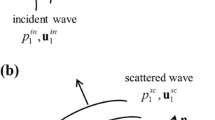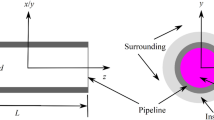The paper analyzes the acoustic emission signals recorded in several places of the sodium hydroxide outflow from the pipeline during manometric control of its tightness directly during operation. On the basis of the obtained results, a parametric image of the source generating acoustic emission at the sodium hydroxide leak locations was established and an assumption was made about its physical nature. Recommendations are given for selecting criteria to assess the hazard class of an acoustic emission source of this type, and the error of its localization using linear antenna groups is estimated. Since the experimental data were obtained by an industrial acoustic emission control system with low-frequency converters, it is possible to directly transfer the obtained results to industrial leak resistance control of extended objects with sodium hydroxide using the acoustic emission method.




Similar content being viewed by others
References
Safe Handling of Caustic Soda (Sodium Hydroxide), Japan Soda Industry Association (2006).
Yu. B. Drobot, V. A. Greshnikov, and V. N. Bachegov, Acoustic Leak Detection [in Russian], Mashinostroenie, Moscow (1989).
V. I. Ivanov and V. A. Barat, Acoustic-Emission Testing: Handbook [in Russian], Publishing House “Spectrum,” Moscow (2017).
V. G. Kharebov, A. V. Zhukov, A. N. Kuzmin, and D. V. Shitov, “Acoustic emission for assessing corrosion damage of pipelines,” V Mire Nerazrush. Kontrol., No. 4, 14–32 (2014).
V. G. Kharebov and Yu. S. Popkov,” Automated systems for complex corrosion monitoring and application potential of acousticemission method as a part of them” [in Russian], V Mire Nerazrush. Kontrol., No. 3(41), 14–17 (2008).
G. V. Katysheva, I. N. Felikidis, O. E. Alekseev, et al., “Characteristics of monitoring a storage tank for sodium hydroxide” [in Russian], Khim. Tekh., No. 3, 38–40 (2016).
I. A. Rastegaev, I. I. Rastegaeva, D. L. Merson, et al., “Assessment of conditions for detecting corrosion cracking of welded joints by acoustic emission method,” Chem. Pet. Eng., 56 (7-8), 554–562 (2020).
L. V. Andreeva, A. S. Novoselova, P. V. Lebedev-Stepanov, et al., “Crystallization of solutes from droplets,” Tech. Phys., 52 (2), 164–172 (2007).
S. P. Molchanov, P. V. Lebedev-Stepanov, and M. V. Alfimov, “Effect of substrate temperature on the self-assembly of particles in the evaporating droplet of colloidal solution,” Nanotechnology Russ., 5, 611–618 (2010).
S. I. Builo, Physico-Mechanical, Statistical, and Chemical Aspects of Acoustic-Emission Testing [in Russian], Izd-vo Yuzhnogo Federal’nogo Universiteta, Rostov-on-Don, Taganrog (2017).
Yu. Yu. Tarasevich, “Mechanisms and models of the dehydration self-organization in biological fluids,” IOP Science: Phys-Usp., 47(7), 717–728 (2004).
X. Wang, Q. Xie, and Y. Huang, “Study on the frequency of acoustic emission signal during crystal growth of salicylic acid,” Nanotechnol. Rev., 10 (1), 596–604 (2021).
A. Anastasopoulos, D. Kourousis, and K. Bollas, “Acoustic emission leak detection of liquid filled buried pipeline,” J. Acoust. Emiss., 27, 27–39 (2009).
G. A. Bigus, A. B. Shchastyantsev, and M. A. Sabrekov, “Application of acoustic-emission method for detecting operational damage in pipelines of heating networks at Norilsk industrial district,” Tekhnol. Mashinostr., No. 7, 46–49 (2016).
A. N. Kuzmin, A. V. Zhukov, E. G. Axelrod, et al., “Advanced technologies of acoustic-emission control in the monitoring of oil and gas complex facilities,” Khimagregaty, No. 4(40), 32–37 (2017).
Author information
Authors and Affiliations
Corresponding author
Additional information
Translated from Khimicheskoe i Neftegazovoe Mashinostroenie, Vol. 59, No. 3, pp. 26–30, March, 2023.
Rights and permissions
Springer Nature or its licensor (e.g. a society or other partner) holds exclusive rights to this article under a publishing agreement with the author(s) or other rightsholder(s); author self-archiving of the accepted manuscript version of this article is solely governed by the terms of such publishing agreement and applicable law.
About this article
Cite this article
Rastegaev, I.A., Khrustalev, A.K., Rastegaeva, I.I. et al. Features of Localization of Sodium Hydroxide Solution Leakage Using Acoustic Emission Method. Chem Petrol Eng 59, 225–231 (2023). https://doi.org/10.1007/s10556-023-01232-2
Published:
Issue Date:
DOI: https://doi.org/10.1007/s10556-023-01232-2




